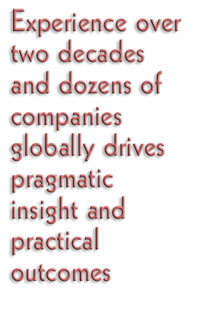Who
Rod has lead an active engineering, management and management consulting career over nearly 25 years. Salient facts include:
- Roderick Keyes Laird is based in Melbourne and was born in 1956.
- Has lived and worked in Melbourne, Sydney and Düsseldorf
- Rod's first working decade was in engineering management, as Director of Australia's largest Biomedical Engineering Institute. This built on his earlier research on recognition technology for the Australian Bionic Ear cochlear implant
- The most recent 16 years have found him engaged in management consulting, first with McKinsey & Co and subsequently with Accenture.
Rod's passion is working as part of an executive team to architect and transform businesses to deliver significant bottom-line impact. All the better if there is a "with a twist of technology" in the challenge. You can access Rod's curriculum vitae if you'd like to find out more about him.
What
Business Impact Architecture represents the selective distillation of sometimes hard-won insight and experience over the last decades. It has evolved with advances in formal management approaches, changing management capabilities and new technologies. Most of all it is driven by what has worked in real businesses; concepts that real managers have adopted and applied to deliver tangible performance impact. The following illustrates the spectrum of contexts in which its concepts have delivered practical outcomes

Business turnaround
- An industrial products business went from delivering hundreds of millions of dollars EBIT to negative cash flows. Focusing the business on customer rather than manufacturing economics drove a complete re-architecture. The Business Impact Architecture Framework or Impact Bridge provided the provided the template to do so. As a result rationalisation of assets and costs - and a complete restructuring of product portfolios and channels - was required. A comprehensive transformation agenda combined cost reduction, capital productivity improvement and margin and share uplifts to return the business to healthy profitability.
Post-Merger Integration
- A global hi-tech company had acquired a smaller competitor, but had neglected to integrate it effectively. Country management took on the task of "back filling". They adopted the Impact Bridge to help it formulate the combined business's strategic proposition - and line up a new integrated business behind it. Soon after, the management team was faced with the task of integrating another acquisition - this time much larger. The incumbent management team confidently applied their business architecture skills to deliver a "global best outcome". Their leadership and transformation mastery overwhelmingly impressed incoming management - previously regarded externally as the "best professionals" of their industry. Some years later, and even larger merger occurred - and the new, integrated management team yet again demonstrated their Impact Bridge mastery to deliver another superbly integrated, rapidly growing business. Yet another "global best outcome".
Strategic re-positioning
- A high tech business had experienced many years of impressive growth on the back of a strong, focused product offer and a outstanding reputation and relationship with its customers. Its challenge was to sustain this growth, based on a spectrum of exciting innovations. The Impact Bridge helped the management team harness their ideas. It crystallised their strategic proposition in a world of multiple, rather than single, products, channels and customer segments. It helped them draw out the implications for fundamental change in their organisation, operation and management approach. And it allowed them to lay out their growth roadmap, confident that their actions and resources all aligned to maximise impact and put them on track to double their value within 5 years
- A national Telco recognised the need to become more market focused. The shift from a function and network-centric operator to included a customer-centric perspective demanded realignment much more than its organisation. Its systems, operations and eventually its product portfolio and network reflected this fundamental shift. The Business Impact Architecture concepts highlighted where and how alignment could proceed pragmatically, step by step.
New venture
- Taking a Business Architecture approach drove the rapid conceptualisation and realisation of a complex business services joint venture employing in excess of 500 personnel and ultimately delivering multiple tens of millions of dollars in net profit.